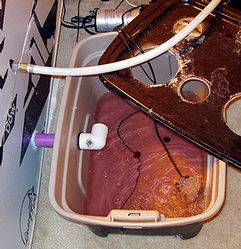Nitrogen and pH shift.....
Nitrogen and pH shift.....
hey POD racers this one's for you.....
Nitrogen fixation chapter 26
Elemental nitrogen is one of the most important nutrients required for plant growth. It is a key constituent of protein, nucleic acids and other cellular components and its availability in the environment frequently limits the growth and yield of crop plants. Most plants acquire N from the soil solution either as nitrate (NO3-) or ammonium (NH+) ions. In addition, some plants are able to utilize the atmospheric N2 pool through symbiotic associations with species of bacteria, cyanobacteria or actinomycetes that contain the N2 fixing enzyme called NITROGENASE.
(so tell us something we don't already know, guineapig.....okay just remember our favorite new enzyme NITROGENASE)
NITROGENASE is a prokaryotic enzyme which catalyzes the reduction of N2 to NH3. It is made up of 2 component proteins......In well-aerated, non-acidic soils, the activity of nitrifying bacteria ensure that virtually all of the available N is present as NO3- (nitrate). Most plants are very efficient at extracting NO3- from their root environment, and are able to maintain tissue or xylem sap concentrations at levels which are much higher than that of the soil solution. Unfortunately, to date the mechanism and regulation of NO3- uptake by the root are not fully understood.......Whatever the mechanism, the uptake of the nitrate anion (NO3-) must be balanced by either the uptake of a cation (e.g. K+, Mg2+, etc.) or the excretion of another anion (e.g. OH- or HCO3-) to maintain electroneutrality in the plant.
(so if K and MG are not provided with your Nitrates the plant will have no choice but to excrete anions and mess up the pH big-time....)
Nitrogen and pH shift.....
hey POD racers this one's for you.....
Nitrogen fixation chapter 26
Elemental nitrogen is one of the most important nutrients required for plant growth. It is a key constituent of protein, nucleic acids and other cellular components and its availability in the environment frequently limits the growth and yield of crop plants. Most plants acquire N from the soil solution either as nitrate (NO3-) or ammonium (NH+) ions. In addition, some plants are able to utilize the atmospheric N2 pool through symbiotic associations with species of bacteria, cyanobacteria or actinomycetes that contain the N2 fixing enzyme called NITROGENASE.
(so tell us something we don't already know, guineapig.....okay just remember our favorite new enzyme NITROGENASE)
NITROGENASE is a prokaryotic enzyme which catalyzes the reduction of N2 to NH3. It is made up of 2 component proteins......In well-aerated, non-acidic soils, the activity of nitrifying bacteria ensure that virtually all of the available N is present as NO3- (nitrate). Most plants are very efficient at extracting NO3- from their root environment, and are able to maintain tissue or xylem sap concentrations at levels which are much higher than that of the soil solution. Unfortunately, to date the mechanism and regulation of NO3- uptake by the root are not fully understood.......Whatever the mechanism, the uptake of the nitrate anion (NO3-) must be balanced by either the uptake of a cation (e.g. K+, Mg2+, etc.) or the excretion of another anion (e.g. OH- or HCO3-) to maintain electroneutrality in the plant.
(so if K and MG are not provided with your Nitrates the plant will have no choice but to excrete anions and mess up the pH big-time....)

 Good to know, eh?
Good to know, eh?













 A good thing.
A good thing.
